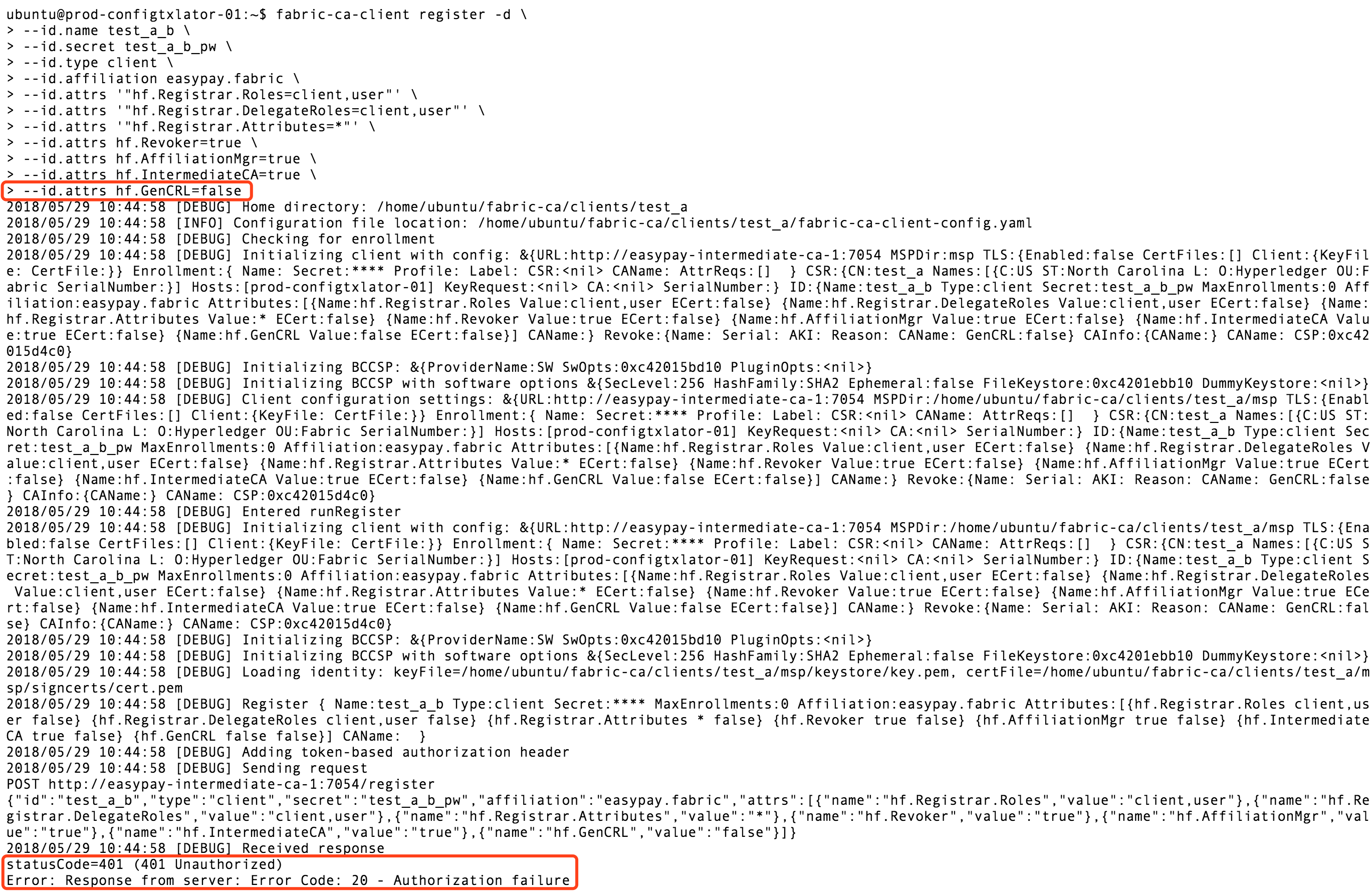жӮЁеҘҪпјҢзҷ»еҪ•еҗҺжүҚиғҪдёӢи®ўеҚ•е“ҰпјҒ
жӮЁеҘҪпјҢзҷ»еҪ•еҗҺжүҚиғҪдёӢи®ўеҚ•е“ҰпјҒ
иҝҷзҜҮж–Үз« з»ҷеӨ§е®¶еҲҶдә«зҡ„жҳҜжңүе…іFabric CAеҲӣе»әз”ЁжҲ·жңәеҲ¶зҡ„зӨәдҫӢеҲҶжһҗзҡ„еҶ…е®№гҖӮе°Ҹзј–и§үеҫ—жҢәе®һз”Ёзҡ„пјҢеӣ жӯӨеҲҶдә«з»ҷеӨ§е®¶еҒҡдёӘеҸӮиҖғпјҢдёҖиө·и·ҹйҡҸе°Ҹзј–иҝҮжқҘзңӢзңӢеҗ§гҖӮ
еңЁз ”究Fabric CA еҲӣе»әз”ЁжҲ·пјҢзҡ„ж—¶еҖҷеҸ‘зҺ°еҫҲеӨҡйҡҗеҗ«и§„еҲҷ
йҖҡиҝҮе®ҳж–№ж–ҮжЎЈпјҢжҲ‘们зҹҘйҒ“ fabric-ca еҸҜд»ҘеёҰжңүеҰӮдёӢеҮ дёӘд»Ҙhf.ејҖеӨҙзҡ„еұһжҖ§пјҢжҲ‘们жҡӮдё”з§°д№Ӣдёәзі»з»ҹеұһжҖ§
| Name | Type | Description |
|---|---|---|
| hf.Registrar.Roles | List | List of roles that the registrar is allowed to manage |
| hf.Registrar.DelegateRoles | List | List of roles that the registrar is allowed to give to a registree for its вҖҳhf.Registrar.RolesвҖҷ attribute |
| hf.Registrar.Attributes | List | List of attributes that registrar is allowed to register |
| hf.GenCRL | Boolean | Identity is able to generate CRL if attribute value is true |
| hf.Revoker | Boolean | Identity is able to revoke a user and/or certificates if attribute value is true |
| hf.AffiliationMgr | Boolean | Identity is able to manage affiliations if attribute value is true |
| hf.IntermediateCA | Boolean | Identity is able to enroll as an intermediate CA if attribute value is true |
йҰ–е…ҲпјҢжҲ‘们用adminеҲӣе»әиҙҰжҲ·test_aпјҢ

е‘Ҫд»ӨеҰӮдёӢпјҡ
fabric-ca-client register -d \ --id.name test_a \ --id.secret test_a_pw \ --id.type client \ --id.affiliation easypay.fabric \ --id.attrs '"hf.Registrar.Roles=client,user"' \ --id.attrs '"hf.Registrar.DelegateRoles=client,user"' \ --id.attrs '"hf.Registrar.Attributes=*"' \ --id.attrs hf.Revoker=true \ --id.attrs hf.AffiliationMgr=true \ --id.attrs hf.IntermediateCA=true \ --id.attrs hf.GenCRL=false
еҚіпјҢи®ҫзҪ®test_aз”ЁжҲ·hf.GenCRL=falseпјҢз»“жһңеҰӮдёӢпјҡ

然еҗҺжҲ‘们е°қиҜ•з”Ёtest_aиҙҰжҲ·еҲҶеҲ«еҲӣе»әд»ҘдёӢеҮ дёӘиҙҰжҲ·(жіЁж„ҸжҳҜз”Ёtest_aиҙҰжҲ·пјҢиҖҢдёҚжҳҜadminиҙҰжҲ·)
test_a_aпјҢи®ҫзҪ®test_a_aз”ЁжҲ·hf.GenCRL=true:
fabric-ca-client register -d \ --id.name test_a_a \ --id.secret test_a_a_pw \ --id.type client \ --id.affiliation easypay.fabric \ --id.attrs '"hf.Registrar.Roles=client,user"' \ --id.attrs '"hf.Registrar.DelegateRoles=client,user"' \ --id.attrs '"hf.Registrar.Attributes=*"' \ --id.attrs hf.Revoker=true \ --id.attrs hf.AffiliationMgr=true \ --id.attrs hf.IntermediateCA=true \ --id.attrs hf.GenCRL=true
з»“жһңеҲӣе»әеӨұиҙҘпјҢдјҡжҠҘжқғйҷҗй”ҷиҜҜпјҢеҰӮдёӢжүҖзӨәпјҡ

test_a_bпјҢи®ҫзҪ®test_a_bз”ЁжҲ·hf.GenCRL=false:
fabric-ca-client register -d \ --id.name test_a_b \ --id.secret test_a_b_pw \ --id.type client \ --id.affiliation easypay.fabric \ --id.attrs '"hf.Registrar.Roles=client,user"' \ --id.attrs '"hf.Registrar.DelegateRoles=client,user"' \ --id.attrs '"hf.Registrar.Attributes=*"' \ --id.attrs hf.Revoker=true \ --id.attrs hf.AffiliationMgr=true \ --id.attrs hf.IntermediateCA=true \ --id.attrs hf.GenCRL=false
з»“жһңеҗҢдёҠпјҡ

test_a_cпјҢдёҚи®ҫзҪ®test_a_cз”ЁжҲ·hf.GenCRLеұһжҖ§:
fabric-ca-client register -d \ --id.name test_a_c \ --id.secret test_a_c_pw \ --id.type client \ --id.affiliation easypay.fabric \ --id.attrs '"hf.Registrar.Roles=client,user"' \ --id.attrs '"hf.Registrar.DelegateRoles=client,user"' \ --id.attrs '"hf.Registrar.Attributes=*"' \ --id.attrs hf.Revoker=true \ --id.attrs hf.AffiliationMgr=true \ --id.attrs hf.IntermediateCA=true
з»“жһңеҲӣе»әжҲҗеҠҹпјҢеҰӮдёӢпјҡ

е…¶д»–еҮ дёӘеёғе°”зұ»еһӢеұһжҖ§пјҢhf.Revoker,hf.AffiliationMgr,hf.IntermediateCA,йғҪжңүзұ»дјјзҺ°иұЎпјҢеҚіпјҢдёҠзә§idиҝҷдәӣеёғе°”еұһжҖ§еҰӮжһңи®ҫзҪ®дёәfalse(жҲ–иҖ…дёҚи®ҫзҪ®)пјҢеҲҷжүҖеҲӣе»әжҳҜдёӢзә§idйғҪдёҚиғҪеёҰжңүеҜ№еә”зҡ„иҝҷдёӘеҮ дёӘеёғе°”зұ»еһӢзҡ„зі»з»ҹеұһжҖ§
hf.Registrar.Rolesзҡ„зәҰжқҹеҲҡжүҚеҲӣе»әзҡ„test_aиә«д»ҪпјҢid.type=client ,hf.Registrar.Roles=client,user, еҰӮжһңжҲ‘们用test_aжіЁеҶҢдёҖдёӘid.type=peerжҲ–иҖ…id.type=ordererзҡ„иә«д»Ҫ з»“жһңдјҡжҖҺж ·е‘ўпјҹеӨ§е®¶еә”иҜҘйғҪжғіеҫ—еҲ°пјҢиӮҜе®ҡжҳҜеӨұиҙҘпјҢиҝҷйҮҢжҲ‘е°ұдёҚеҒҡжөӢиҜ•дәҶ
еӨҮжіЁпјҡfabric-ca 1.1 зүҲжң¬ hf.Registrar.Roles еұһжҖ§еҸӘж”ҜжҢҒclient,user,peer,ordererеӣӣз§ҚпјҢ1.2зүҲжң¬еҚіе°Ҷж”ҜжҢҒиҮӘе®ҡд№үи§’иүІпјҢиҜҰи§Ғпјҡhttps://jira.hyperledger.org/browse/FAB-7882
зӣёе…іиө„ж–ҷжҲӘеӣҫпјҡ





з”Ё test_a з”ЁжҲ·еҲӣе»әдёҖдёӘ test_a_dиә«д»ҪпјҢи®ҫзҪ®test_a_dеұһжҖ§hf.Registrar.Roles=client,user,peer ,еҰӮдёӢпјҡ
fabric-ca-client register -d \ --id.name test_a_d \ --id.secret test_a_d_pw \ --id.type client \ --id.affiliation easypay.fabric \ --id.attrs '"hf.Registrar.Roles=client,user,peer"' \ --id.attrs '"hf.Registrar.DelegateRoles=client,user,peer"' \ --id.attrs '"hf.Registrar.Attributes=*"' \ --id.attrs hf.Revoker=true \ --id.attrs hf.AffiliationMgr=true \ --id.attrs hf.IntermediateCA=true
з»“жһңеҲӣе»әеӨұиҙҘпјҢеҰӮдёӢпјҡ

еҸҜд»Ҙ继з»ӯеҫҖдёӢжөӢиҜ•пјҢеҸҜд»ҘеҸ‘зҺ°пјҢеҪ“test_aиә«д»Ҫзҡ„еұһжҖ§hf.Registrar.Roles=client,user пјҢеҫҖдёӢз”Ёtest_aиә«д»ҪеҲӣе»әзҡ„еӯҗиә«д»Ҫзҡ„f.Registrar.RolesеұһжҖ§еҖјйғҪдёҚиғҪи¶…иҝҮclient,userзҡ„иҢғеӣҙ
еҶҚз”Ё test_a з”ЁжҲ·еҲӣе»әдёҖдёӘ test_a_eиә«д»ҪпјҢи®ҫзҪ®test_a_e еұһжҖ§id.type=peer ,еҰӮдёӢпјҡ
fabric-ca-client register -d \ --id.name test_a_e \ --id.secret test_a_e_pw \ --id.type peer \ --id.affiliation easypay.fabric \ --id.attrs '"hf.Registrar.Roles=client,user"' \ --id.attrs '"hf.Registrar.DelegateRoles=client,user"' \ --id.attrs '"hf.Registrar.Attributes=*"' \ --id.attrs hf.Revoker=true \ --id.attrs hf.AffiliationMgr=true \ --id.attrs hf.IntermediateCA=true
з»“жһңеҲӣе»әеӨұиҙҘпјҢй”ҷиҜҜдҝЎжҒҜеҰӮдёӢ:

еӯҗ id зҡ„id.typeеұһжҖ§еҖјд№ҹеҸ—еҲ°дёҠзә§idзҡ„hf.Registrar.RolesеұһжҖ§еҖјзҡ„зәҰжқҹ
hf.Registrar.Attributes еұһжҖ§зҡ„зәҰжқҹе°қиҜ•з”Ё admin иә«д»Ҫ еҲӣе»ә test_b пјҢж·»еҠ hf.key=value
fabric-ca-client register -d \ --id.name test_b \ --id.secret test_b_pw \ --id.type client \ --id.attrs hf.key=value
еҚідҪҝadminиә«д»Ҫhf.Registrar.Attributes=*,иҝҳжҳҜеҲӣе»әеӨұиҙҘпјҢз»“жһңеҰӮеӣҫ

еҶҚе°қиҜ•з”Ё admin иә«д»Ҫ еҲӣе»ә test_c,ж·»еҠ hf=value
fabric-ca-client register -d \ --id.name test_c \ --id.secret test_c_pw \ --id.type client \ --id.attrs hf=value
еҲӣе»әжҲҗеҠҹпјҢз»“жһңеҰӮеӣҫ

жҖ»з»“дёӢжқҘпјҢжңүд»ҘдёӢеҮ зӮ№и§„еҫӢпјҡ
дёҠзә§idзҡ„hf.Registrar.AttributesеҖјеҸҜд»ҘзәҰжқҹе®ғжүҖеҲӣе»әзҡ„еӯҗзә§idиғҪж·»еҠ зҡ„еұһжҖ§пјҢдҪҶжҳҜеёҰhf.зҡ„йҷӨеӨ–пјҢеёҰhf.ејҖеӨҙзҡ„дјҡиў«еҪ“еҒҡзі»з»ҹеұһжҖ§пјҢеҢәеҲ«еҜ№еҫ…
д»ҺдёҠзә§еҫҖдёӢпјҢжүҖеёҰзҡ„еұһжҖ§зәҰжқҹеҸӘиғҪжҳҜйҖҗжёҗ收ж•ӣзҡ„пјҢдёҚиғҪеҸ‘ж•Ј
ж„ҹе…ҙи¶ЈеҸҜд»ҘиҜҰз»Ҷз ”з©¶дёҖдёӢжәҗд»Јз Ғ зӣёе…ійғЁеҲҶд»Јз ҒеҸҜд»ҘеҸӮи§Ғпјҡhttps://github.com/hyperledger/fabric-ca/blob/release-1.1/lib/attr/attribute.go


ж„ҹи°ўеҗ„дҪҚзҡ„йҳ…иҜ»пјҒе…ідәҺвҖңFabric CAеҲӣе»әз”ЁжҲ·жңәеҲ¶зҡ„зӨәдҫӢеҲҶжһҗвҖқиҝҷзҜҮж–Үз« е°ұеҲҶдә«еҲ°иҝҷйҮҢдәҶпјҢеёҢжңӣд»ҘдёҠеҶ…е®№еҸҜд»ҘеҜ№еӨ§е®¶жңүдёҖе®ҡзҡ„её®еҠ©пјҢи®©еӨ§е®¶еҸҜд»ҘеӯҰеҲ°жӣҙеӨҡзҹҘиҜҶпјҢеҰӮжһңи§үеҫ—ж–Үз« дёҚй”ҷпјҢеҸҜд»ҘжҠҠе®ғеҲҶдә«еҮәеҺ»и®©жӣҙеӨҡзҡ„дәәзңӢеҲ°еҗ§пјҒ
е…ҚиҙЈеЈ°жҳҺпјҡжң¬з«ҷеҸ‘еёғзҡ„еҶ…е®№пјҲеӣҫзүҮгҖҒи§Ҷйў‘е’Ңж–Үеӯ—пјүд»ҘеҺҹеҲӣгҖҒиҪ¬иҪҪе’ҢеҲҶдә«дёәдё»пјҢж–Үз« и§ӮзӮ№дёҚд»ЈиЎЁжң¬зҪ‘з«ҷз«ӢеңәпјҢеҰӮжһңж¶үеҸҠдҫөжқғиҜ·иҒ”зі»з«ҷй•ҝйӮ®з®ұпјҡis@yisu.comиҝӣиЎҢдёҫжҠҘпјҢ并жҸҗдҫӣзӣёе…іиҜҒжҚ®пјҢдёҖз»ҸжҹҘе®һпјҢе°Ҷз«ӢеҲ»еҲ йҷӨж¶үе«ҢдҫөжқғеҶ…е®№гҖӮ